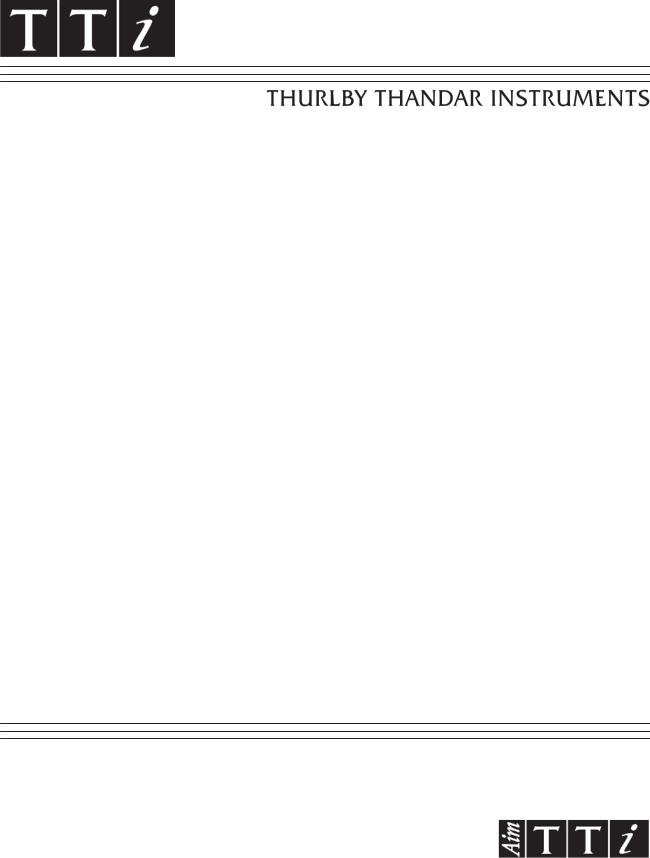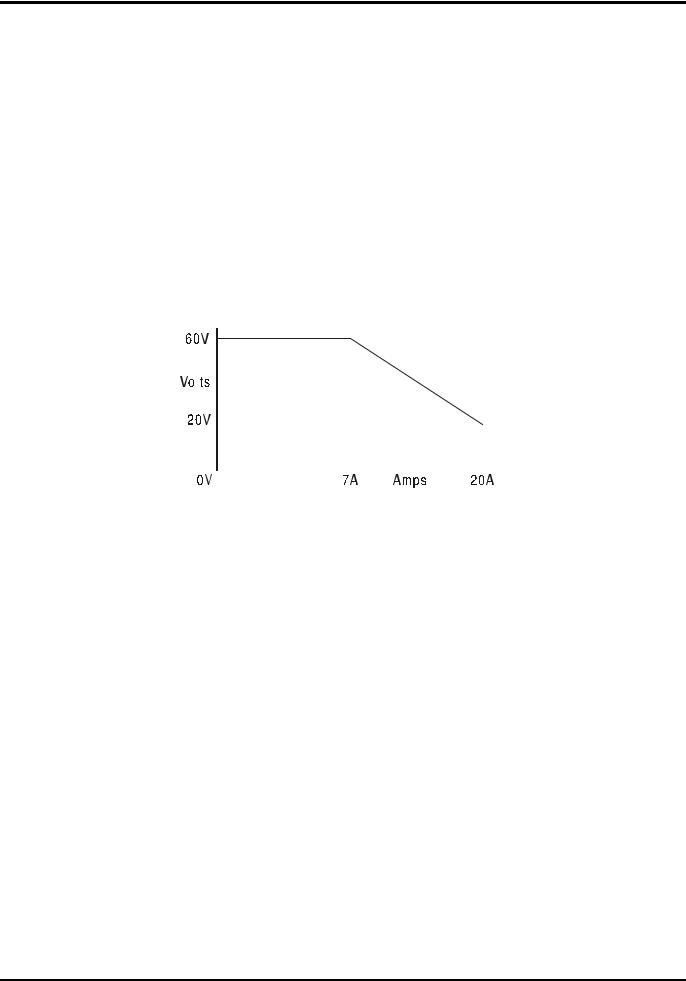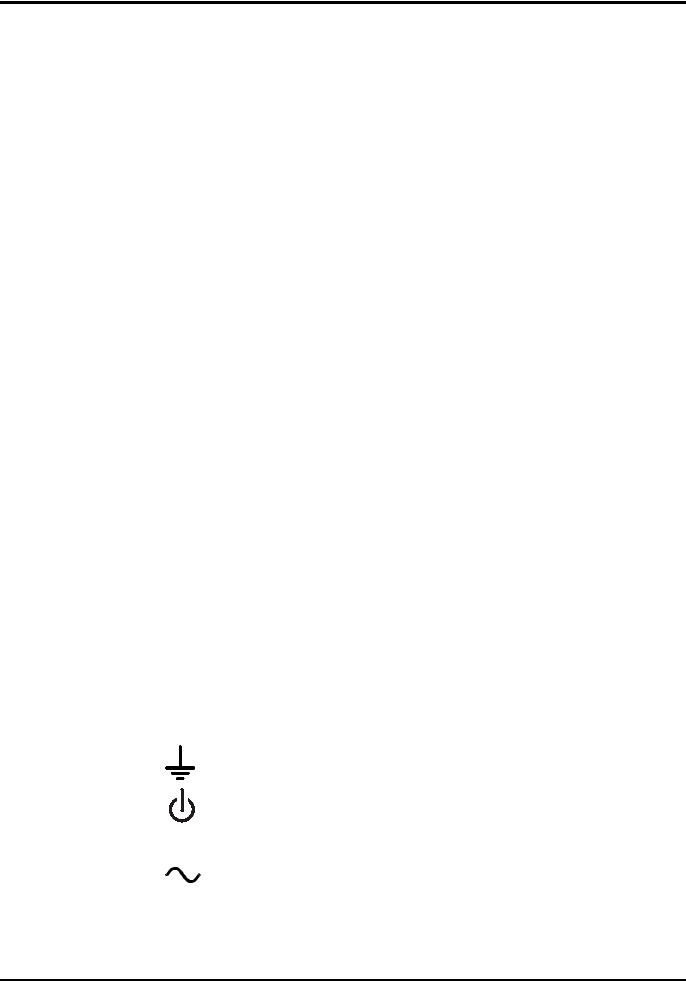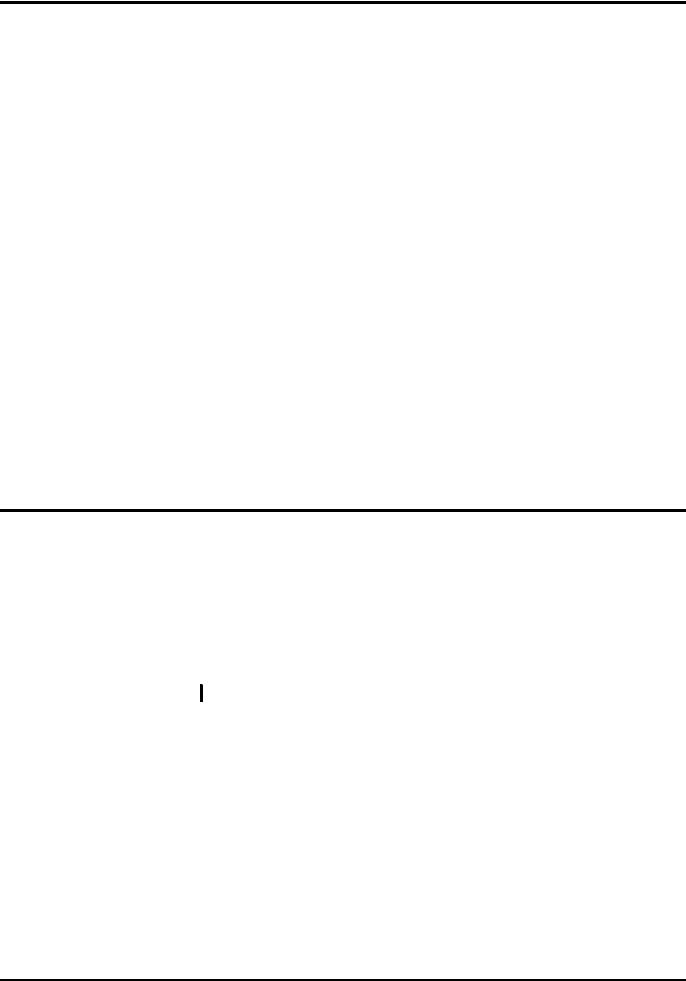Thurlby Thandar Instruments CPX400A User Manual [en, de, fr, it]

CPX400A
Dual 60V 20A PowerFlex Power Supply INSTRUCTION MANUAL

Table of Contents
Specification |
2 |
Safety |
4 |
EMC |
6 |
Installation |
7 |
Connections |
7 |
Operation |
8 |
Maintenance |
10 |
Instructions en Francais |
11 |
Bedienungsanleitung auf Deutsch |
16 |
Istruzioni in Italiano |
22 |
Instrucciones en Español |
27 |
1

Specification
General specifications apply for the temperature range 5°C to 40°C. Accuracy specifications apply for the temperature range 18°C to 28°C after 1 hour warm-up with no load and calibration at 23°C. Typical specifications are determined by design and are not guaranteed.
OUTPUT SPECIFICATIONS
Voltage Range: |
|
|
0V to 60V |
||||||||||||||||||||||||||||
Current Range: |
|
|
0A to 20A |
||||||||||||||||||||||||||||
Power Range: |
|
|
Up to 420W |
||||||||||||||||||||||||||||
Output Voltage Setting: |
|
|
By coarse and fine controls. |
||||||||||||||||||||||||||||
Output Current Setting: |
|
|
By single logarithmic control. |
||||||||||||||||||||||||||||
Operating Mode: |
|
|
Constant voltage or constant current with automatic cross-over provided |
||||||||||||||||||||||||||||
|
|
|
that the power demanded stays within the power envelope, see graph. |
||||||||||||||||||||||||||||
|
|
|
Outside of this envelope the output becomes unregulated. |
||||||||||||||||||||||||||||
|
|
|
|
|
|
|
|
|
|
|
|
|
|
|
|
|
|
|
|
|
|
|
|
|
|
|
|
|
|
|
|
|
|
|
|
|
|
|
|
|
|
|
|
|
|
|
|
|
|
|
|
|
|
|
|
|
|
|
|
||||
|
|
|
|
|
|
|
|
|
|
|
|
|
|
|
|
|
|
|
|
|
|
|
|
|
CPX 400A |
|
|||||
|
|
|
|
|
|
|
|
|
|
|
|
|
|
||||||||||||||||||
|
|
|
|
|
|
|
|
|
|
|
|
|
|
||||||||||||||||||
|
|
|
|
|
|
|
|
|
|
|
|
|
|
|
|
|
|
|
|
|
|
|
|
|
POWER ENVELOPE |
|
|||||
|
|
|
|
|
|
|
|
|
|
|
|
|
|
||||||||||||||||||
|
|
|
|
|
|
|
|
|
|
|
|
|
|
||||||||||||||||||
|
|
|
|
|
|
|
|
|
|
|
|
|
|
|
|
|
|
|
|
|
|
|
|
|
|
|
|
|
|
|
|
|
|
|
|
|
|
|
|
|
|
|
|
|
|
|
|
|
|
|
|
|
|
|
|
|
|
|
|
|
|
|
|
|
|
|
|
|
|
|
|
|
|
|
|
|
|
|
|
|
|
|
|
|
|
|
|
|
|
|
|
|
|
|
|
|
|
|
|
|
|
|
|
|
|
|
|
|
|
|
|
|
|
|
|
|
|
|
|
|
|
|
|
|
|
|
|
|
|
|
|
|
|
|
|
|
|
|
|
|
|
|
|
|
|
|
|
|
|
|
|
|
|
|
|
|
|
|
|
|
|
|
|
|
|
|
|
|
|
|
|
|
|
|
|
|
|
|
|
|
|
|
|
|
|
|
|
|
|
|
|
|
|
|
|
|
|
|
|
|
|
|
|
|
|
|
|
|
|
|
|
|
|
|
|
|
|
|
|
|
|
|
|
|
|
|
|
|
|
|
|
|
|
|
|
|
|
|
|
|
|
|
|
|
|
|
|
|
|
|
|
|
|
|
|
|
|
|
|
|
|
|
|
|
|
|
|
|
|
|
|
|
|
|
|
|
|
|
|
|
|
|
|
|
|
|
|
Output Switch: |
Electronic. Preset voltage and current displayed when off. |
Output Terminals: |
Universal 4mm safety binding posts on 19mm (0·75”) pitch. 30A max. |
Sensing: |
Switchable between local and remote. Spring-loaded push terminals for |
|
remote connection. |
Output Protection: |
Forward protection by Over-Voltage Protection (OVP) trip; maximum |
|
voltage that should be applied to the terminals is 70V. |
|
Reverse protection by diode clamp for reverse currents up to 3A. |
Over-temperature Protection: |
The output will be tripped off if a fault causes the internal temperature to |
|
rise excessively. |
OVP Range: |
10% to 110% of maximum output voltage set by front panel screwdriver |
|
adjustment. |
Line Regulation: |
Change in output for a 10% line change: |
|
Constant voltage: <0.01% of maximum output |
|
Constant current: <0.01% of maximum output |
Load Regulation: |
Change in output for any load change within PowerFlex envelope, |
|
remote sense connected: |
|
Constant voltage: <0.01% of maximum output |
|
Constant current: <0.05% of maximum output |
Ripple & Noise |
4mVrms max; typically <2mVrms, <10mV pk-pk, at maximum load, CV |
(20MHz bandwidth): |
mode. |
2

Transient Load Response: |
<250us to within 50mV of set level for a 5% to 95% load change. |
Temperature Coefficient: |
Typically <100ppm/°C |
Status Indication: |
Output on lamp. |
|
Constant voltage mode lamp. |
|
Constant current mode lamp. |
|
Unregulated (power limit) lamp |
|
Trip message on display. |
METER SPECIFICATIONS
Meter Types: |
Dual 4 digit meters with 12.5mm (0.5") LEDs. Reading rate 4 Hz. |
Meter Resolutions: |
10mV, 10mA |
Meter Accuracies: |
Voltage 0.1% of reading ± 2 digits, |
|
Current 0.3% of reading ± 2 digits |
GENERAL
AC Input: |
110V – 240V AC ± 10%, 50/60Hz. |
|
Installation Category II. |
Power Consumption: |
1250VA max. |
Operating Range: |
+5ºC to +40ºC, 20% to 80% RH. |
Storage Range: |
−40ºC to + 70ºC. |
Environmental: |
Indoor use at altitudes up to 2000m, Pollution Degree 2. |
Safety: |
Complies with EN61010-1. |
EMC: |
Complies with EN61326. |
Size: |
210 x 130 x 375mm (WxHxD) half rack width x 3U height (optional |
|
rack mounting kit available). |
Weight: |
6kg |
3

Safety
This power supply is a Safety Class I instrument according to IEC classification and has been designed to meet the requirements of EN61010-1 (Safety Requirements for Electrical Equipment for Measurement, Control and Laboratory Use). It is an Installation Category II instrument intended for operation from a normal single phase supply.
This instrument has been tested in accordance with EN61010-1 and has been supplied in a safe condition. This instruction manual contains some information and warnings which have to be followed by the user to ensure safe operation and to retain the instrument in a safe condition.
This instrument has been designed for indoor use in a Pollution Degree 2 environment in the temperature range 5°C to 40°C, 20% - 80% RH (non-condensing). It may occasionally be subjected to temperatures between +5°C and –10°C without degradation of its safety. Do not operate while condensation is present.
Use of this instrument in a manner not specified by these instructions may impair the safety protection provided. Do not operate the instrument outside its rated supply voltages or environmental range.
WARNING! THIS INSTRUMENT MUST BE EARTHED
Any interruption of the mains earth conductor inside or outside the instrument will make the instrument dangerous. Intentional interruption is prohibited. The protective action must not be negated by the use of an extension cord without a protective conductor.
When the instrument is connected to its supply, terminals may be live and opening the covers or removal of parts (except those to which access can be gained by hand) is likely to expose live parts. The apparatus shall be disconnected from all voltage sources before it is opened for any adjustment, replacement, maintenance or repair. Capacitors inside the power supply may still be charged even if the power supply has been disconnected from all voltage sources but will be safely discharged about 10 minutes after switching off power.
Any adjustment, maintenance and repair of the opened instrument under voltage shall be avoided as far as possible and, if inevitable, shall be carried out only by a skilled person who is aware of the hazard involved.
If the instrument is clearly defective, has been subject to mechanical damage, excessive moisture or chemical corrosion the safety protection may be impaired and the apparatus should be withdrawn from use and returned for checking and repair.
Make sure that only fuses with the required rated current and of the specified type are used for replacement. The use of makeshift fuses and the short-circuiting of fuse holders is prohibited.
Do not wet the instrument when cleaning it.
The following symbols are used on the instrument and in this manual:-
l
Earth (ground) terminal.
Instrument in STAND-BY
mains supply ON. alternating current (ac)
4

EC Declaration of Conformity
We |
Thurlby Thandar Instruments Ltd |
|
Glebe Road |
|
Huntingdon |
|
Cambridgeshire PE29 7DR |
|
England |
declare that the
CPX400A 60V 20A Bench Power Supply
meet the intent of the EMC Directive 2004/108/EC and the Low Voltage Directive 2006/95/EC. Compliance was demonstrated by conformance to the following specifications which have been listed in the Official Journal of the European Communities.
EMC |
|
|
|
|
Emissions: |
a) |
EN61326-1 (2006) |
Radiated, Class B |
|
|
b) EN61326-1 (2006) |
Conducted, Class B |
||
|
c) EN61326-1 (2006) |
Harmonics, referring to EN61000-3-2 (2006) |
||
Immunity: |
EN61326-1 (2006) Immunity Table 1, referring to: |
|||
|
a) |
EN61000-4-2 (2009) |
Electrostatic Discharge |
|
|
b) |
EN61000-4-3 (2006) |
Electromagnetic Field |
|
|
c) |
EN61000-4-11 (2004) Voltage Interrupt |
||
|
d) |
EN61000-4-4 (2004) |
Fast Transient |
|
|
e) |
EN61000-4-5 (2006) Surge |
||
|
f) |
EN61000-4-6 (2009) |
Conducted RF |
|
Performance levels achieved are detailed in the user manual.
Safety
EN61010-1 Installation Category II, Pollution Degree 2.
CHRIS WILDING TECHNICAL DIRECTOR
2 January 2013
5

EMC
This instrument has been designed to meet the requirements of the EMC Directive 2004/108/EC. Compliance was demonstrated by meeting the test limits of the following standards:
Emissions
EN61326-1 (2006) EMC product standard for Electrical Equipment for Measurement, Control and Laboratory Use. Test limits used were:
a)Radiated: Class B
b)Conducted: Class B
c)Harmonics: EN61000-3-2 (2006) Class A; the instrument is Class A by product category.
Immunity
EN61326-1 (2006) EMC product standard for Electrical Equipment for Measurement, Control and Laboratory Use.
Test methods, limits and performance achieved are shown below (requirement shown in brackets):
a)EN61000-4-2 (2009) Electrostatic Discharge : 4kV air, 4kV contact, Performance A (B).
b)EN61000-4-3 (2006) Electromagnetic Field:
3V/m, 80% AM at 1kHz, 80MHz – 1GHz: Performance A (A) and
1.4GHz to 2GHz: Performance A (A); 1V/m, 2.0GHz to 2.7GHz: Performance A (A).
c)EN61000-4-11 (2004) Voltage Interrupt:
½-cycle, 0%: Peformance A (B); 1 cycle, 0%: Performance B (B);
25 cycles, 70%: Performance A (C); 250 cycles, 0%: Performance B (C).
d)EN61000-4-4 (2004) Fast Transient, 1kV peak (AC line), 0·5kV peak (DC Outputs), Performance B (B).
e)EN61000-4-5 (2006) Surge, 0·5kV (line to line), 1kV (line to ground), Performance B (B).
f)EN61000-4-6 (2009) Conducted RF, 3V, 80% AM at 1kHz (AC line only; DC Output connections <3m, therefore not tested), Performance A (A).
According to EN61326-1 the definitions of performance criteria are:
Performance criterion A: ‘During test normal performance within the specification limits.’
Performance criterion B: ‘During test, temporary degradation, or loss of function or performance which is self-recovering’.
Performance criterion C: ‘During test, temporary degradation, or loss of function or performance which requires operator intervention or system reset occurs.’
Where Performance B is stated it is because DC Output regulation, or V & I measurement accuracy, may deviate beyond Specification limits under the test conditions. However, the possible deviations are still small and unlikely to be a problem in practice.
Note that if operation in a high RF field is unavoidable it is good practice to connect the PSU to the target system using screened leads which have been passed (together) through an absorbing ferrite sleeve fitted close to the PSU terminals.
Cautions
To ensure continued compliance with the EMC directive observe the following precautions:
a)after opening the case for any reason ensure that all signal and ground connections are remade correctly and that case screws are correctly refitted and tightened.
b)In the event of part replacement becoming necessary, only use components of an identical type, see the Service Manual.
6

Installation
Mains Operating Voltage
This instrument has a universal input range and will operate from a nominal 115V or 230V mains supply without adjustment. Check that the local supply meets the AC Input requirement given in the Specification.
Mains Lead
Connect the instrument to the AC supply using the mains lead provided. Should a mains plug be required for a different mains outlet socket, a suitably rated and approved mains lead set should be used which is fitted with the required wall plug and an IEC60320 C13 connector for the instrument end. To determine the minimum current rating of the lead-set for the intended AC supply, refer to the power rating information on the equipment or in the Specification.
WARNING! THIS INSTRUMENT MUST BE EARTHED.
Any interruption of the mains earth conductor inside or outside the instrument will make the instrument dangerous. Intentional interruption is prohibited.
Ventilation
The power supply is cooled by an intelligent multi-speed fan which vents at the rear. Take care not to restrict the air inlets at top, bottom and side panels or the exit at the rear. In rack-mounted situations allow adequate space around the instrument and/or use a fan tray for forced cooling.
Mounting
This instrument is suitable both for bench use and rack mounting. It is delivered with feet for bench mounting. The front feet include a tilt mechanism for optimal panel angle.
A rack kit for mounting one or two of these Half-width 3U high units in a 19” rack is available from the Manufacturers or their overseas agents.
Connections
All connections are made from the front panel.
The load should be connected to the positive (red) and negative (black) terminals marked OUTPUT. The OUTPUT terminals are rated at 30A.
Remote sense connections to the load, if required, are made from the positive (+) and negative (−) SENSE terminals. Switch the LOCAL/REMOTE switch to REMOTE when remote sensing is required. Switch back to LOCAL when remote sensing is not in use.
The terminal marked 




 is connected to the chassis and safety earth ground.
is connected to the chassis and safety earth ground.
7

Operation
The operation of both outputs is identical; the following description applies to both.
Switching On
The power switch, located at the bottom left of the front panel, switches between standby ( ) and on ( l ). In standby the auxiliary power circuit remains connected and consumes ~6 Watts.
) and on ( l ). In standby the auxiliary power circuit remains connected and consumes ~6 Watts.
To fully disconnect from the AC supply unplug the mains cord from the back of the instrument or switch off at the AC supply outlet; make sure that the means of disconnection is readily accessible. Disconnect from the AC supply when not in use.
Setting Up the Output
With the POWER switch on ( l ) and the OUTPUT switch off the output voltage and current limit can be accurately preset using the VOLTAGE and CURRENT controls; the upper meter shows the set voltage and the lower meter shows the set maximum current.
When the OUTPUT switch is switched on, the OUTPUT ON lamp and the CV (constant voltage) lamp light; the upper meter continues to show the set voltage but the lower meter now shows the actual load current.
Constant Voltage
The output voltage is adjusted using the coarse and fine VOLTAGE control; the CURRENT control sets the maximum current that can be supplied.
The CV lamp lights to show constant voltage mode.
Constant Current
If the load resistance is low enough such that, at the output voltage set, a current greater than the current limit setting would flow, the power supply will automatically move into constant current operation. The current output is adjusted by the CURRENT control and the VOLTAGE controls set the maximum voltage that can be generated.
The CI lamp lights to show constant current mode.
Instantaneous Current Output
The current limit control can be set to limit the continuous output current to levels down to 10mA. However, in common with all precision bench power supplies, a capacitor is connected across the output to maintain stability and good transient response. This capacitor charges to the output voltage and short-circuiting of the output will produce a current pulse as the capacitor discharges which is independent of the current limit setting.
Power Limit
The maximum output at different voltage settings is limited by the power envelope illustrated below:
CPX 400A
POWER ENVELOPE
8

The power envelope is set to give 62V/7A, 42V/10A and 20V / 20A under all supply conditions (both outputs loaded); at lower output voltages the output power is restricted by the 20A current maximum.
When the power limit is exceeded, the status indication will change from CV or CI to UNREG. For example, if the supply is set to 20V, with the current limit at maximum, and is connected to a 2Ω load, 10 Amps will flow and the supply will be in CV mode. As the voltage across the load is increased, the power into the load increases until, at about 29V, the power limit is exceeded and the supply changes from CV to UNREG.
Connection to the Load
The load should be connected to the positive (red) and negative (black) OUTPUT terminals. Both are fully floating and either can be connected to ground.
Remote Sensing
The unit has a very low output impedance, but this is inevitably increased by the resistance of the connecting leads. At high currents this can result in significant differences between the indicated source voltage and the actual load voltage (two 5mΩ connecting leads will drop 0.2V at 20 Amps, for instance). This problem can be minimised by using short, thick, connecting leads, but where necessary it can be completely overcome by using the remote sense facility.
This requires the sense terminals to be connected to the output at the load instead of at the source; insert wires into the spring-loaded SENSE terminals and connect directly to the load. Switch the LOCAL/REMOTE switch to REMOTE. To avoid instability and transient response problems, care must be taken to ensure good coupling between each output and sense lead. This can be done either by twisting the leads together or by using coaxially screened cable (sense through the inner). An electrolytic capacitor directly across the load connection point may also be beneficial.
The voltage drop in each output lead must not exceed 0.5 Volts.
Switch the LOCAL/REMOTE switch back to LOCAL when remote sensing is not in use.
Series or Parallel connection with other units
The outputs of the power supply are fully floating and may be used in series with other power supply units to generate high DC voltages up to 300V DC.
WARNING! Such voltages are exceedingly hazardous and great care should be taken to shield the output terminals for such use. On no account should the output terminals be touched when the unit is switched on under such use. All connections to the terminals must be made with the power switched off on all units.
It should be noted that the unit can only source current and cannot sink it, thus units cannot be series connected in anti-phase.
The unit can be connected in parallel with others to produce higher currents. Where several units are connected in parallel, the output voltage will be equal to that of the unit with the highest output voltage setting until the current drawn exceeds its current limit setting, upon which the output will fall to that of the next highest setting, and so on. In constant current mode, units can be connected in parallel to provide a current equal to the sum of the current limit settings.
Note that the output terminals are rated at 30A maximum; if two or more outputs are operated in parallel to source higher currents than this the junction should be made at a separate point, not one of the terminals.
Protection
Overvoltage protection (OVP) is fully variable within the range 10% to 110% of the supply's maximum output level. The OVP limit is set via the screwdriver adjustable SET OVP preset potentiometer, accessible through a hole in the front panel. Rotating the preset clockwise increases the limit, which can be read directly on the user display by pressing the button beneath the preset. If the voltage on the output exceeds the set OVP for any reason, including an externally forced voltage, the output will be tripped off.
The output will also be tripped off if an attempt is made to draw power from the sense wires.
9
